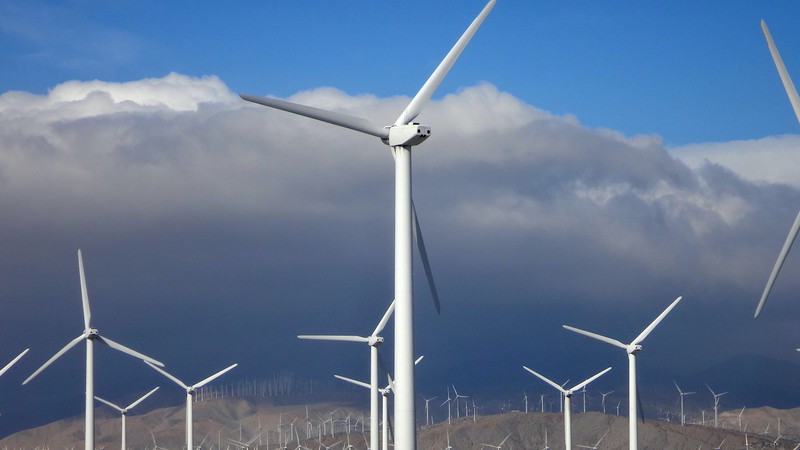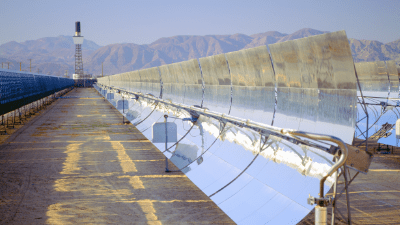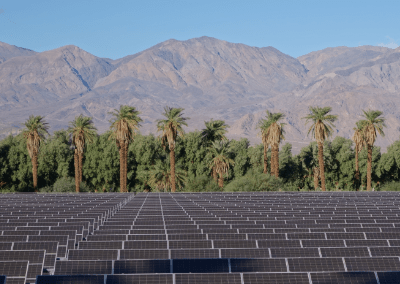What are ‘CCAs’ and how are they helping California hold off climate change?

California has set a goal of 100 percent clean energy by 2045. Eric Wilde / Wikimedia Commons C.C. 2.0 Share-Alike License
Once largely the journalistic purview of science reporters and Al Gore documentaries, global warming has gone mainstream. The climate crisis piled up more media coverage at the end of 2021 than at any point in United States media history. According to one study, not only did global media outlets mention climate change more than ever before in the latter months of 2021, but reporters more frequently used emphatic terms such as “climate catastrophe,” or “emergency.”
But California did not wait for the climate crisis to start trending. Two decades earlier, the state legislature passed a law, AB 117, that allowed local governments to form a new type of electricity service provider called a Community Choice Aggregator, or CCA.
This new entity takes the responsibility for purchasing energy, and deciding what type of energy will be purchased, out of the hands of big, private power companies—of which only three supply about three-fourths of all electricity in California—and gives that choice to members of the community, as the name implies, via their elected representatives.
CCAs: More Climate-Friendly Than the Big Utility Companies
What does this mean for the climate? CCAs in California have already proved more efficient than the big, private companies—known as Investor-Owned Utilities or IOUs—at delivering energy derived from renewable sources, rather than by burning fossil fuels. According to a study by UCLA’s Luskin Center, the average CCA delivers 52 percent of its electricity from renewables.

By comparison, PG&E, the IOU serving most of northern and central California, provides 33 percent of its electricity from renewable sources “including solar, wind, geothermal, small hydroelectric and various forms of bioenergy,” the company says.
The San Diego counterpart to PG&E, SDG&E, claimed in 2018 that it derived a relatively impressive 45 percent of the energy it sold from renewable sources, but according to the California Energy Commission, the company was engaging in a bit of creative energy accounting. The following year, the Commission instituted new rules for how energy providers may calculate their renewable percentage.
After the rule change, SDG&E’s percentage dropped to 31. The reason for the drop was that, under the new rules, power companies were no longer allowed to count “renewable energy credits” (also called Renewable Energy Certificates, or RECs) toward their total amount of renewable energy delivered. RECs can be bought and sold. Though they represent actual amounts of renewable energy generated, they do not correspond to the amount of renewable energy used by a company’s customers. They can be sold to buyers who merely seek, as one paper published by University of San Diego School of Law put it, “green bragging rights.”
As for the third California IOU, Southern California Edison reported 34 percent of its energy coming from renewables in 2019—though by including nuclear power and large hydroelectric plants, the company claimed that 48 percent of its energy was “carbon free.”
California law requires utility companies to generate 60 percent of their energy from renewable sources by 2030. And the goal for 2045 is 100 percent—meaning that by then the state’s biggest power companies would, at least in theory, no longer contribute to climate change, and would stop using energy sources that pollute the air and other elements of the environment.
What Is It, Exactly, That CCAs Do?
About a quarter of the state’s electricity is supplied by 44 publicly owned utility companies, or POUs, the largest of which—in fact, the largest POU in the United States—is the Los Angeles Department of Water and Power (LADWP). In 2022, according to Los Angeles Mayor Eric Garcetti, the LADWP will derive 60 percent of the energy it supplies to residents of the state’s most populous city from renewable, “clean” sources.

Solar power plant in Death Valley.
Geoff Hardy, Shutterstock
In September of 2021, the city council there voted to require the LADWP to reach 100 percent clean energy by 2035, a full decade before the statewide deadline.
If POUs supply 25 percent of the state’s power and IOUs the other 75 percent, where do Community Choice Aggregators fit in? There are 24 CCAs in the state. With 100 percent of the state’s energy coming from IOUs or POUs, what are those CCAs doing?
In fact, Community Choice Aggregation is a policy idea. It doesn’t create new sources of power or distribute energy, which remains the job of IOUs and POUs. A city or county that makes the choice to form a CCA—which is a nonprofit entity—puts the responsibility for purchasing energy from various sources into the hands of elected officials, while the IOU continues to handle distribution and charge the CCA for those costs. In most cases, however, the local officials who tend not to be experts in the dazzlingly complex ins and outs of the energy market outsource that task to professional energy service providers who work directly for the CCA and are paid out of customer fees.
CCAs can be formed only in jurisdictions served by investor-owned utilities. In California, IOUs are regulated by the state’s Public Utilities Commission, while POUs are not. Consumers who live in an area covered by a CCA are automatically enrolled, though under the 2002 law they may opt out, in most cases without cost.
So how do CCAs do a better job at offering cleaner energy than the established utilities? By offering customers a choice of packages, and tailoring their energy purchases to fulfill those choices. CCAs generally offer three energy plans: a default plan, a plan that focuses mainly on solar power, and finally the most expensive plan, which promises 100 percent renewable energy sources.
How Did CCAs Originate?
Only nine states in addition to California permit the formation of Community Choice Aggregators, according to the United States Environmental Protection Agency. They are Illinois, Maryland, Massachusetts, New Hampshire, New Jersey, New York, Ohio, Rhode Island, and Virginia. But this is one area of environmental policy where California, though on the cutting edge, was not first. That honor belongs to Massachusetts, where CCAs were first authorized in 1997.
This is one area of environmental policy where California, though on the cutting edge, was not first.
The 21 towns on Cape Cod and Martha’s Vineyard, as well as some nearby islands, joined to form the Cape Light Compact, a CCA which continues to operate today.
In California, CCAs grew out of the energy crisis of 2000 (which dragged on into 2001) when the state for a complex variety of reasons suffered a series of rolling blackouts due to disruptions in the power supply. Three years earlier, under Gov. Pete Wilson, the state had deregulated the energy market. Among other effects, the deregulation allowed customers to shop around for alternative sources of electricity. But when the crisis hit, the state suspended the consumer choice options.
In response, the legislature passed AB 117 on 2002, but it wasn’t for another eight years that a local government took advantage of the law. Marin County formed Marin Clean Energy. The CCA now operates as a Joint Powers Authority, also serving communities in Napa, Solano and Contra Costa counties, with a customer base topping 100,000.
Long form articles which explain how something works, or provide context or background information about a current issue or topic.